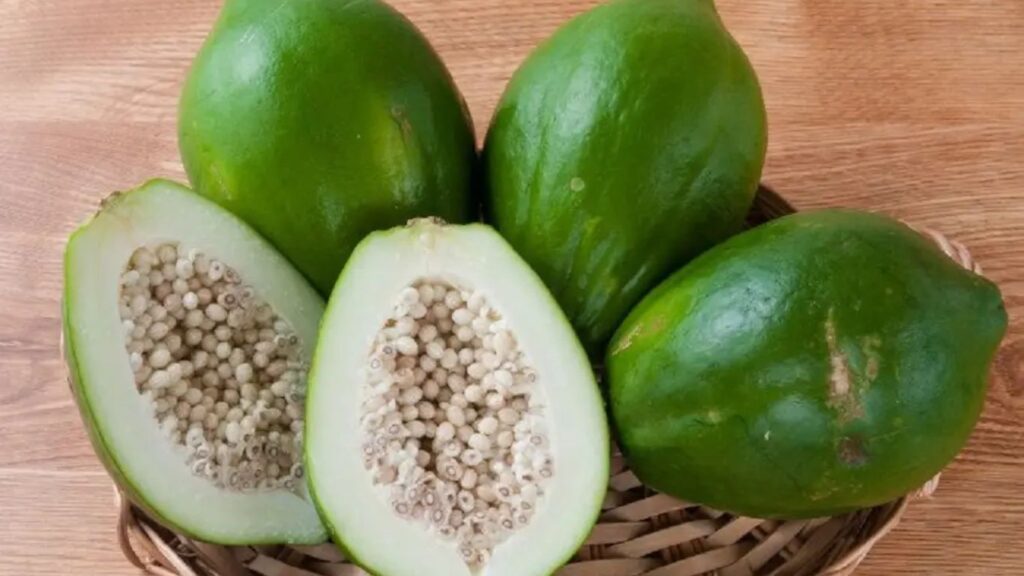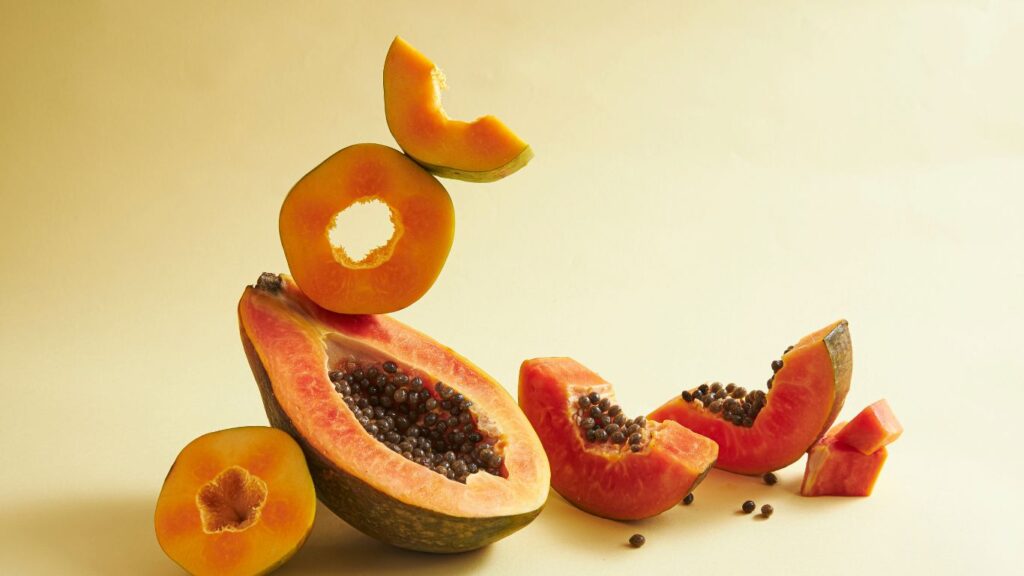Papaya, a tropical fruit cherished for its vibrant color and sweet taste, undergoes significant transformations from its raw, green state to its ripe, golden form. This blog explores these changes, particularly focusing on the shifts in the nutritional profiles between raw and ripe papayas. Understanding these differences is not just a matter of satisfying culinary curiosity but is crucial for making informed dietary choices. For health-conscious individuals, knowing which stage of ripeness offers more of specific nutrients can guide decisions that align with dietary needs and health goals. Whether it’s maximizing digestive enzyme intake or boosting antioxidant consumption, the choice between raw and ripe papaya can impact various aspects of health. This log aims to demystify these nutritional dynamics, providing readers with the knowledge needed to harness the full health potential of this versatile fruit in both its green and gold stages.
Green vs. Gold: Exploring the Nutritional Shifts from Raw to Ripe Papaya
The Journey from Green to Gold: Understanding Ripening
The ripening process of papayas is a fascinating interplay of biological and chemical changes that transform the fruit from its hard, green, raw state to a soft, golden, ripe delicacy. Initially, raw papayas contain high levels of papain, an enzyme that breaks down as the fruit ripens, gradually reducing its concentration. This enzymatic action is crucial for softening the fruit’s flesh. Ethylene, a natural plant hormone, is produced internally and triggers the ripening process, enhancing sugar content and decreasing acidity, which sweetens the fruit.
Visually, ripe papayas are easy to distinguish. They transition from a vibrant green to a rich golden-yellow or orange color. Texturally, the fruit softens significantly; what was once firm and unyielding becomes yielding to gentle pressure. The skin may also appear more wrinkled as it ripens, and the fruit emits a sweet, tropical fragrance, signaling its readiness for consumption. These visual and textural cues are essential for determining the perfect time to enjoy the fruit at its peak flavor and nutritional value.
Nutritional Profile of Raw Papaya

Raw papaya is a powerhouse of essential nutrients, including the standout enzyme papain, along with a rich supply of vitamins A, C, E, and various B vitamins, and minerals like potassium and magnesium. Papain, the star enzyme of raw papaya, is particularly notable for its proteolytic properties, which means it can break down proteins into smaller peptides and amino acids. This makes papain an excellent aid in digestion, particularly in breaking down tough meat fibers, which can help alleviate digestive issues such as bloating and constipation. Moreover, papain exhibits significant anti-inflammatory properties. It helps reduce inflammation in the body, which can be beneficial for those suffering from arthritis, asthma, and other inflammatory conditions. The vitamins and minerals in raw papaya further bolster the immune system, enhance skin health, and support overall cellular function, making raw papaya a valuable addition to a health-conscious diet.
Nutritional Changes in Ripe Papaya
As papaya ripens, its nutritional profile undergoes notable changes, particularly with increases in vitamin C and beta-carotene. These nutrients are more concentrated in the ripe fruit, offering greater health benefits. Vitamin C, essential for immune function and skin health, sees a significant increase as the fruit matures, providing a potent antioxidant boost. Beta-carotene, which the body converts to vitamin A, also escalates during ripening. This nutrient is crucial for maintaining healthy vision, skin, and immune responses.
The ripening process not only increases these nutrients but also enhances their bioavailability. The softening of the fruit’s flesh makes it easier for the digestive system to access and extract these vital compounds. Additionally, the natural breakdown of complex compounds into simpler forms during ripening allows the body to more efficiently absorb antioxidants and vitamins, maximizing the health benefits derived from eating ripe papaya.
Comparing Health Benefits: Raw vs. Ripe
The following table outlines how both raw and ripe papaya serve different health benefits, making them valuable in varied dietary contexts :
| Aspect | Raw Papaya | Ripe Papaya |
|---|---|---|
| Main Nutrients | High in papain, fiber | High in vitamin C, beta-carotene |
| Digestive Health | Papain helps in breaking down proteins, easing digestion. | Softer, more fibrous texture aids in regular bowel movements. |
| Anti-inflammatory | Papain has anti-inflammatory properties reducing symptoms of arthritis and inflammation-related pains. | Lesser than raw but still effective. |
| Antioxidant Support | Lower than ripe but contains other beneficial enzymes. | Rich in antioxidants like vitamin C and beta-carotene which help in reducing oxidative stress. |
| Immune Health | Supports immune function but less effectively than ripe papaya. | Enhanced immune support due to higher vitamin C content. |
| Scientific Studies | Studies show papain’s effectiveness in protein digestion and inflammation control. | Studies highlight the increased bioavailability of vitamin C and its impact on immune health (Journal of Nutrition and Food Sciences). |
| Expert Opinion | Dr. Jane Wilson notes its benefits for digestive health due to high papain content. | Dr. Jane Wilson recommends for its immune-boosting properties due to high antioxidant levels. |
Practical Tips: How to Incorporate Both in Your Diet

Incorporating both raw and ripe papayas into your diet can add variety and boost your nutritional intake. Raw papaya can be grated into salads or made into a spicy Thai papaya salad, enhancing meals with its digestive benefits. For a simple dish, mix grated raw papaya with carrots, lime juice, fish sauce, and peanuts. Ripe papaya is delicious when blended into smoothies or served as a dessert with a squeeze of lime. It can also be cubed and added to fruit salads for a sweet, antioxidant-rich treat.
However, there are precautions to consider. Some individuals may be allergic to papaya, especially if they have a latex allergy, as papaya contains chitinases that can cause cross-reactivity. Additionally, consuming large amounts of raw papaya may lead to digestive upset due to its potent papain content, so it’s best to consume it in moderation.
Conclusion
Both raw and ripe papayas offer distinct nutritional benefits that can enhance your health in different ways. From aiding digestion and reducing inflammation with raw papaya to boosting antioxidant levels and immune health with ripe papaya, this versatile fruit provides a range of healthful properties at every stage of its maturity. By understanding the specific nutritional shifts that occur from green to gold, you can tailor your intake to suit your health needs. Whether incorporated into salads, smoothies, or enjoyed on its own, papaya is a delightful addition to a health-conscious diet, adaptable in its raw or ripe form.
Also read: Java Plum for Diabetes Management
